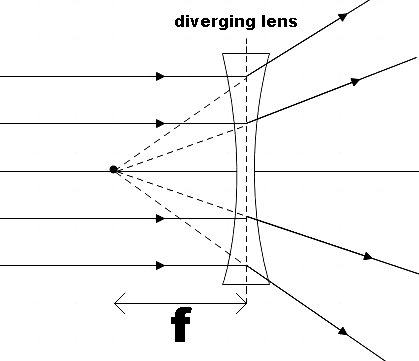
How are converging lenses different from diverging lenses?
Answer
549.3k+ views
Hint: You could first define and hence understand what exactly these converging and diverging lenses are. Then you could find out the reason behind their very name and hence get the major difference between them. You could now discuss the image formed by both of them to get another difference.
Complete answer:
In the question, we are asked as to how converging lenses are different from that of diverging lenses. Before, answering that let us firstly understand what exactly these converging and diverging lenses are.
You may recall that both convex lens and concave lenses are spherical lenses whose two surfaces form a part of some spherical surface. When both the sides of a spherical lens are curved outward it is called a convex lens. They are also called converging lenses as they bend light from infinity towards a point which is the focal point of that lens. Hence, we could say that these rays are being converged to that point.

On the other hand, if both sides are found to be curved inward, they are called concave lenses. Another name for this class of lenses is diverging lens. The rays from infinity after refraction are found to diverge from a particular point which is the focal point and hence the name.

You may recall that by convention, the focal length of a diverging lens is negative and that of a converging lens is positive. The difference also lies in the nature of the image formed by the two lenses. The image formed by the converging lenses are found to be real or virtual, however the image formed is always virtual in the case of diverging lenses.
Therefore, we saw how converging lenses are different from diverging lenses.
Note:
By convention, all the measurements are done with respect to the optic axis of the lens. So, the measurements taken to the left of the lens are taken negative and that taken to the right is considered positive. This is how we have determined the sign of the focal length in both the cases of concave and convex lenses.
Complete answer:
In the question, we are asked as to how converging lenses are different from that of diverging lenses. Before, answering that let us firstly understand what exactly these converging and diverging lenses are.
You may recall that both convex lens and concave lenses are spherical lenses whose two surfaces form a part of some spherical surface. When both the sides of a spherical lens are curved outward it is called a convex lens. They are also called converging lenses as they bend light from infinity towards a point which is the focal point of that lens. Hence, we could say that these rays are being converged to that point.

On the other hand, if both sides are found to be curved inward, they are called concave lenses. Another name for this class of lenses is diverging lens. The rays from infinity after refraction are found to diverge from a particular point which is the focal point and hence the name.

You may recall that by convention, the focal length of a diverging lens is negative and that of a converging lens is positive. The difference also lies in the nature of the image formed by the two lenses. The image formed by the converging lenses are found to be real or virtual, however the image formed is always virtual in the case of diverging lenses.
Therefore, we saw how converging lenses are different from diverging lenses.
Note:
By convention, all the measurements are done with respect to the optic axis of the lens. So, the measurements taken to the left of the lens are taken negative and that taken to the right is considered positive. This is how we have determined the sign of the focal length in both the cases of concave and convex lenses.
Recently Updated Pages
Master Class 12 English: Engaging Questions & Answers for Success

Master Class 12 Business Studies: Engaging Questions & Answers for Success

Master Class 12 Economics: Engaging Questions & Answers for Success

Master Class 12 Social Science: Engaging Questions & Answers for Success

Master Class 12 Maths: Engaging Questions & Answers for Success

Master Class 12 Chemistry: Engaging Questions & Answers for Success

Trending doubts
What are the major means of transport Explain each class 12 social science CBSE

Which are the Top 10 Largest Countries of the World?

Draw a labelled sketch of the human eye class 12 physics CBSE

Explain sex determination in humans with line diag class 12 biology CBSE

Explain sex determination in humans with the help of class 12 biology CBSE

Differentiate between homogeneous and heterogeneous class 12 chemistry CBSE




